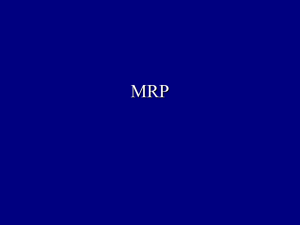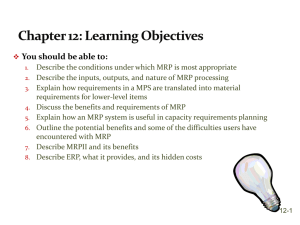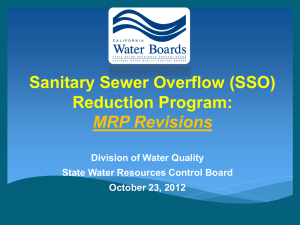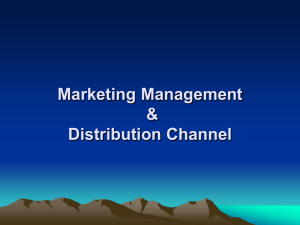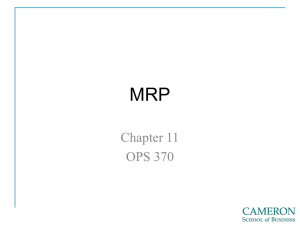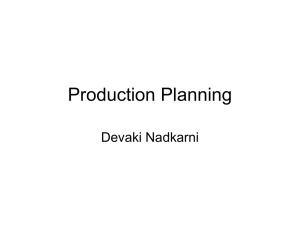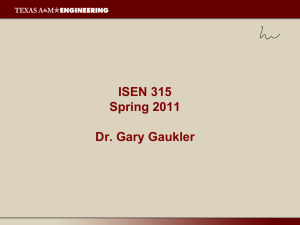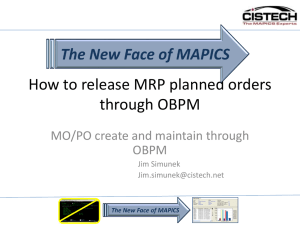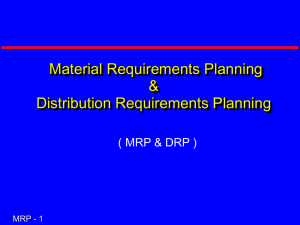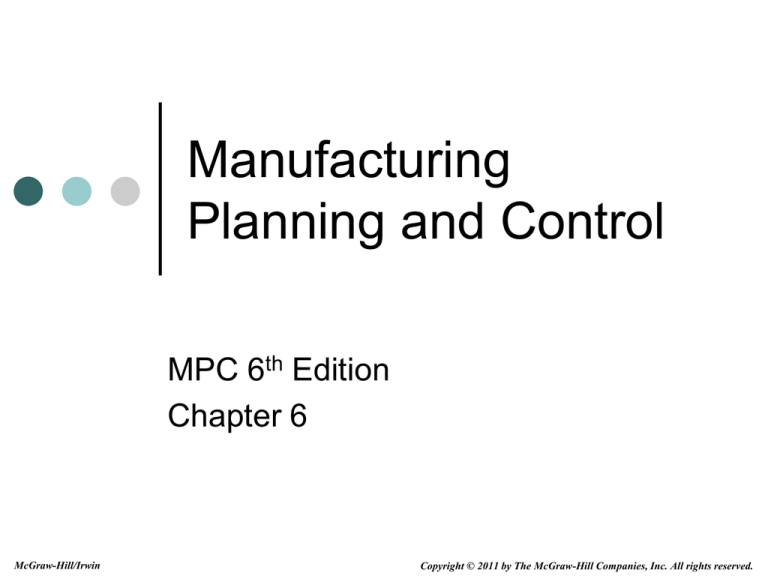
Manufacturing
Planning and Control
MPC 6th Edition
Chapter 6
McGraw-Hill/Irwin
Copyright © 2011 by The McGraw-Hill Companies, Inc. All rights reserved.
Material Requirements
Planning (MRP)
Material Requirements Planning
(MRP) has the managerial objective
of providing “the right part at the
right time” to meet the schedules for
completed products.
MRP provides a formal plan for each
part number–raw materials,
components, and finished products.
6-2
Agenda
What is Material Requirements Planning (MRP)?
MRP and Manufacturing Planning & Control
MRP Record Processing
MRP Technical Issues
Using the MRP System
MRP System Dynamics
6-3
Manufacturing Planning and Control System
Sales and operations
planning
Master production
scheduling
Routing
file
Bills of
material
Detailed capacity
planning
Detailed material
planning
Demand
management
Front End
Inventory
status
data
Time-phased
requirement (MRP)
records
Engine
Material and
capacity plans
Shop-floor
systems
Supplier
systems
Enterprise Resource Planning (ERP) System
Resource
planning
Back End
6-4
Basic MRP Record
Gross
Requirements
Scheduled
Receipts
MRP
Record
Projected
Available Balance
Planned Order
Releases
6-5
Basic MRP Record
A previously
released order
due in period 1
Requirements
from all
sources
On hand 1
Gross requirements
4
5
40
10
4
44
50
4
54
Planned order releases
Lead time = 1 period
Lot size = 50
3
10
Scheduled receipts
Projected available balance
2
Period
44
44
50
A unreleased
order due in
period 5
6-6
Bill of Materials
The BOM shows the
components and
sub-assemblies
required to produce
a product
6-7
Product Structure Diagram
Finished product is
located at the top,
components below
Sub-assemblies
are represented
by separate
levels
6-8
Indented Bill of Materials
Finished item is not indented
Level 2 sub-assemblies
Level 1 sub-assemblies
Level 1 components
Components and sub-assemblies are indented relative to their
order of usage
6-9
Explosion
Explosion–the process of translating product
requirements into component part requirements
Considers existing inventories and scheduled
receipts
Calculating the quantities of all components
needed to satisfy requirements for any given
part.
Continued until all parts have been considered,
leading to exact requirements for all purchased
and/or raw material parts
6-10
Gross and Net
Requirements
Gross requirements represent the total
planned usage for the part
Net requirements account for existing
inventory and/or scheduled receipts
100 req’d –
25 inventory
= 75 net req’d
Net req’d for
assembly
becomes gross
req’d for
component
75 req’d – 22
inventory – 25
sched. rec. =
28 net req’d
6-11
Demand Types in MRP
Dependent–component or sub-assembly
demand driven by net requirements from the
next higher level (e.g. scoop demand caused
by net requirements for scoop assemblies)
Independent–demand driven by requirements
from outside the firm (e.g. customer orders)
6-12
Lead Time Offsetting
Gross to net explosion shows how much of
each part is required, but not when
Timing requires consideration of two factors
Lead times–how long does it take to obtain
the component or sub-assembly
Precedent relationships–the order in which
parts must be assembled
MRP considers both factors when developing
the plan
6-13
Scheduling Logic
Two common approaches to scheduling
exist
Front schedule–schedule each step as early
as possible
Back schedule–schedule each step as late
as possible
MRP combines back scheduling and gross
to net explosion
Reduced inventories
Minimized storage time
6-14
Back Scheduling
Top handle
assembly has the
longest duration of
any sub-assembly
Scoop assembly
must be complete
before final
assembly can begin
Only when all subassemblies and
components are
available can final
assembly begin
6-15
MRP Records
Planned order release
for top handle assembly
becomes gross
requirement for top
handle component and
nail (note 2 nails
required per assembly)
Lot-for-lot order policy
exactly matches supply
to net requirements
Fixed lot size order
policy requires orders in
multiples of lot size
6-16
MRP Technical Issues
Processing frequency–recalculating all records and
requirements is called regeneration
This is a computationally intensive process so it is often
run in the background and during periods of low system
demand
Net change approach only recalculates those
records that have experienced changes
Less frequent processing results in an out-of-date
picture
More frequent processing increases computer
costs and may lead to system nervousness
6-17
Safety Stock and Safety
Lead Time
Safety stock is buffer stock over and above
the quantity needed to satisfy gross
requirements
Used when quantity uncertainty is the issue
Safety lead time changes both the release
and due date of shop and/or purchase orders
to provide a margin for error
Used when timing of orders is the issue
Safety lead time is not just an inflated lead
time
6-18
Pegging
Pegging provides a link between demand
(order releases, customer orders, etc.) and
the gross requirements for parts
Pegging records include the specific part
numbers associated with a gross
requirement
Pegging information can track the impact of a
problem (e.g. material shortage) back to the
order(s) it will affect
6-19
Firm Planned Orders
Regeneration of the MRP records can lead
to large numbers of planned order changes
To avoid this, a planned order can be
converted to a firm planned order (FPO)
An FPO is not the same as a scheduled
delivery, but can’t be changed by the MRP
system
Temporarily overrides the MRP system to
provide stability or to solve problems
6-20
Planning Horizon
Total amount of time included in MRP
calculations
Longer planning horizon increases
computational requirements
Shorter planning horizon may result in lesseffective plans if significant future demand is
not visible
At a minimum, should cover the cumulative
lead time for all finished goods items
6-21
Scheduled Receipts vs.
Planned Order Releases
Scheduled receipts represent an actual commitment
(purchase order, production order, etc.)
Planned orders are only the current plan and can be
changed more easily
Scheduled receipts for production orders already
have component materials assigned
Scheduled receipts do not impact gross requirements
Planned order releases do not have component
materials assigned
Planned order releases do impact gross requirements
6-22
Using the MRP System
MRP Planner
Exception Codes
MRP
Aspects
Bottom-Up
Replanning
MRP System
Output
6-23
MRP Planner Tasks
Release
Reschedule
Analyze and Update
Reconcile
Identify Problems
Solve Shortages
Enhance
• Purchase orders
• Shop floor (production) orders
• Change due dates of existing orders (when desirable)
• Set lot sizes and lead times
• Adjust scrap allowances and safety stocks
• Identify errors and inconsistencies and eliminate their root
causes
• Take action now to prevent future crises
• Adjust records and system parameters to prevent recurrence
• Identify system enhancements to improve performance
6-24
Exception Codes
Separating the vital few from
the trivial many
Requirements
that cannot be
Part numbers
Orders with
satisfied
with planned
unsatisfactory
orders in the
within system
timing or
parameters
immediate
quantity
period
(management
input needed)
6-25
Bottom-Up Replanning
Using pegging data to guide efforts to solve
material shortages
Pegging data allows the planner to take
action only when actual customer orders are
impacted
6-26
MRP System Output
Part number and description
MRP system data
MRP planning data
Exception messages
6-27
MRP System Dynamics
MRP System Issues
Transactions
during a
period–
unexpected
changes
Rescheduling–
moving the
due date of an
order to an
earlier or later
date
Complex
transactions–
inventory
adjustments,
service parts,
etc.
Procedural
inadequacies–
situations the
system wasn’t
designed to
handle
6-28
Principles
Effective use of an MRP system allows development of a
forward-looking approach to managing material flows.
The MRP system provides a coordinated set of linked
product relationships, which permits decentralized decision
making for individual part numbers.
All decisions made to solve problems must be implemented
within the system, and transactions must be processed to
reflect the resultant changes.
Effective use of exception messages allows attention to be
focused on the “vital few” rather than the “trivial many.”
6-29
Quiz – Chapter 6
Material Requirements Planning (MRP) takes place in the
front end systems of the manufacturing planning and control
system? (True/False)
In a Material Requirements Planning (MRP) system, what
does time-phasing of gross requirements mean?
Front scheduling logic starts each step of the process as late
as possible? (True/False)
A lot-for-lot order policy generates orders for a fixed quantity,
independent of actual requirements? (True/False)
Processing all Material Requirements Planning (MRP)
records in a single computer run is called ___________?
Safety lead time involves inflating lead times to ensure stock
6-30
availability? (True/False)


